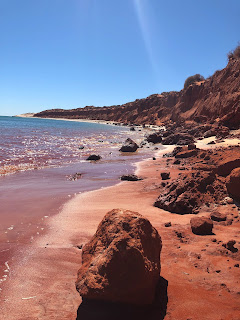Chemical weathering is a
destructive process that changes minerals and speeds the physical breakdown of
rocks. Oxidation is a form of chemical weathering due to minerals reacting with
oxygen in the presence of water.
Rusting rocks?
Rust is a familiar product of the
oxidation of iron. Water with acid or salt is an electrolyte. Iron dissolves in
the electrolyte and reacts with oxygen, forming iron oxide. Iron oxide is a
weaker substance than the original iron, so it crumbles and washes away easily.
Iron items may be galvanised or painted to protect them from rusting.
This iron door has begun to crumble due to rust.
This basalt has been cut to show the difference between the fresh interior and the oxidised outer surface.
Australia looks red from space due to oxidation of our ancient rocks. The ancient
rocks that make up Australia have weathered over millions of years, without
being eroded into the oceans. The iron and aluminium oxides have remained on
land and formed the distinctive red centre of Australia and red rocks
throughout the continent.
Iron oxide from weathered rocks washes into the ocean in Francois Peron National Park, WA.
Explore
- Try some quick oxidation reactions at home as shown in our video Oxidation Weathering and described in this WASP teacher resource.
- Discover the impact of weathering in WASP resources.
- Learn about chemical (acid), physical and biological weathering in the PALMS videos.
- Learn more about the chemistry of rusting from Reactions.
- You can read about the details of chemical weathering in this open geology textbook from the University of British Columbia.




